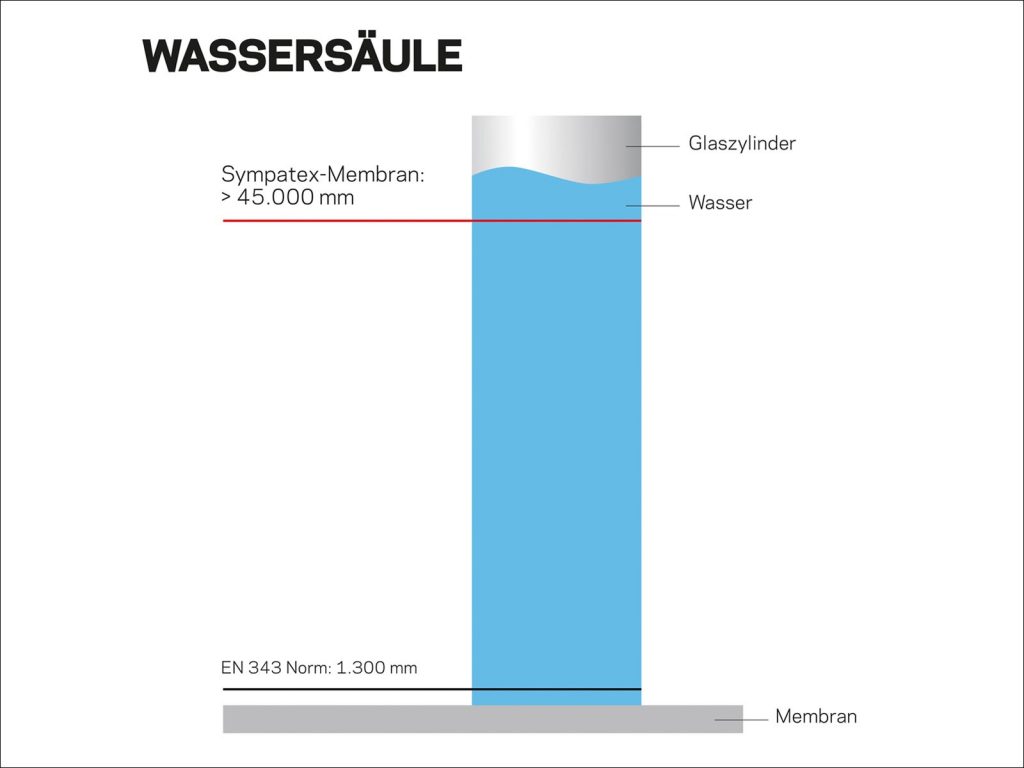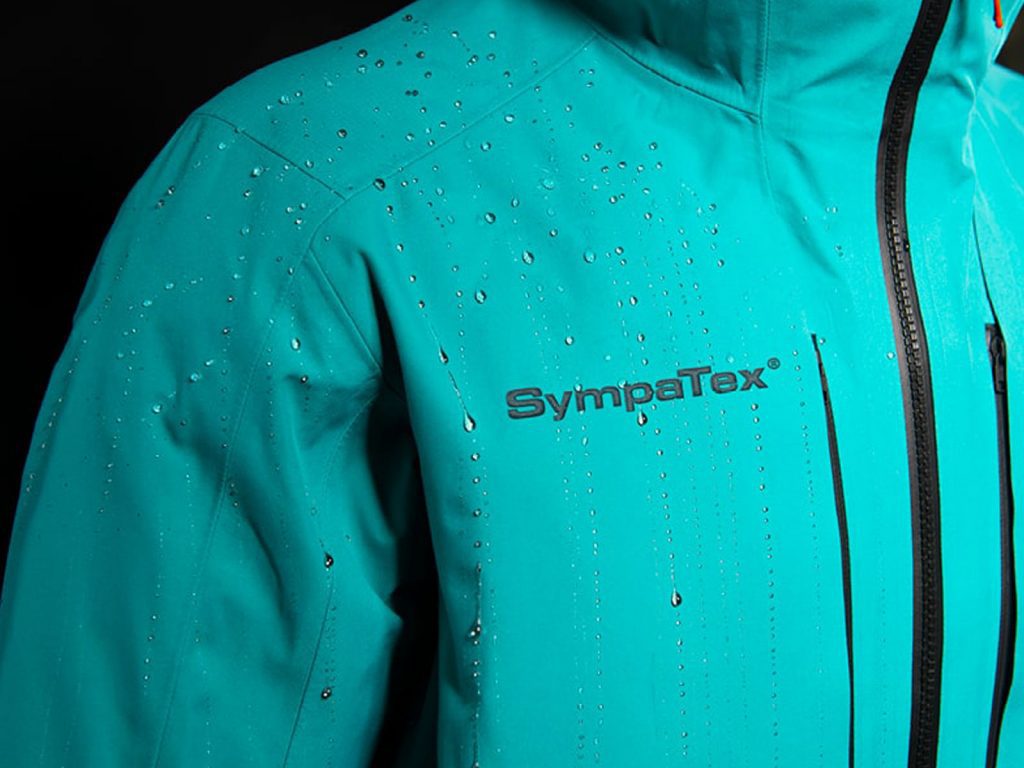Waterproof rain jackets: tips for buying
- minutes reading time
Nature and outdoor enthusiasts are at some point confronted with the question, how do I stay dry on long hikes even in the event of sudden rain showers or continuous rain? There is only one solution: A waterproof rain jacket is a must! But there are some things to consider when buying it.

Sascha, what is the difference between water-repellent and waterproof?
Sascha Buchhauser: «In the case of a rain jacket, one speaks of waterproof if the entire material of the jacket is waterproof and all seams are sealed with a so-called seam sealing tape. If, on the other hand, the seams of the jacket are not or only partially welded, then it is called a water-repellent jacket. Jackets made with Sympatex material are generally always waterproof.»
So you should pay close attention to what is indicated on the hang tag when buying?
Sascha Buchhauser: «Exactly, often it is indicated on the hang tag whether the seams of the jacket have been completely or only partially welded. If they have been completely welded, then you can be sure that it is a waterproof jacket. “

The so-called water column is also repeatedly used as a quality criterion for rain jackets. What does this say about the waterproofness of a jacket?
Sascha Buchhauser: «The water column tells us something about how much water pressure the material can withstand until it gets damp on the inside. If a membrane can withstand a water column of at least 1,300 millimeters, it is waterproof. We guarantee a water column of 20,000 millimetres for our Sympatex material; our membrane even achieves a water column of 45,000 millimetres. Retailers often specify water columns of more than 30,000 millimetres for commercially available rain jackets – but this is unnecessary, as a water column exceeding 20,000 millimetres is never required in normal use.»
That means a high water column says nothing about the quality of the rain jacket?
Sascha Buchhauser: «Of course, the individual brands always «battle up» a little and try to generate even higher figures for their jackets. Because for the customer, a higher figure naturally always sounds better. But in general it can be said that a water column of 20,000 millimeters is quite sufficient.«

What other quality criteria should I look for when buying a raincoat?
Sascha Buchhauser: «In any case on whether it is a waterproof or just a water-repellent jacket and on the breathability of the product.»
And how do I find out about the breathability of the product?
Sascha Buchhauser: «With the so-called Moisture Vapour Transmission Rate, often labelled as MVTR. The MVTR score provides information about the amount of evaporated liquid per square meter in 24 hours. The higher this score is, the more breathable the jacket is. From 3,000g per square metre in 24 hours we speak of a breathable or water vapour permeable jacket.“
Does it make a difference if I buy a coated rain jacket or a rain jacket with a membrane?
Sascha Buchhauser: «Yes, it makes a difference, because a fabric that has only one coating will not remain waterproof in the long run and has poor breathability. Every outer fabric that is used for a rain jacket should have an impregnation or DWR coating. DWR stands for «Durable Water Repellency», which can be translated as «permanent water repellency». This allows the water that comes from the outside to bead up on the fabric without the material becoming soaked with water. In the past, a lot of work was done with chemicals containing PFC in order to maintain the impregnation for as long as possible. In the meantime, there are also pollutant-free solutions without the use of harmful chemicals, the so-called PFC-free impregnations. We at Sympatex work exclusively with PFC-free impregnations that are harmless to the environment.»
Does this mean I should look for the label «PFC-free» when I buy?
Sascha Buchhauser: «Right! Usually «PFC free» is written on the hangtag or on an extra label. This guarantees a pollution-free impregnation.«

What other things should I take into account when it comes to sustainability?
Sascha Buchhauser: «Nowadays, you should pay attention to whether or how much recycled material is in the jacket. And under no circumstances should you fall back on products that are not recyclable at all. Everything made from pure polyester is recyclable in any case, and if the membrane is also recyclable, like our Sympatex membrane, then this has the advantage that the jacket is almost completely recyclable.»
Are there special seals that I can look out for when buying a sustainable and pollutionfree rain jacket?
Sascha Buchhauser: «There are now a large number of seals, and as an end consumer it is often difficult to keep track of them. One seal that we at Sympatex work with and have had good experience with is the OEKO-TEX® certificate. We also have a long-standing partnership with bluesign® and have been certified by them. For us, these are the two most important seals in terms of sustainability.»

If I am now looking for a sustainable raincoat in the store – what questions should I ask the sales staff? Or are there brands that I can rely on to guarantee that they only offer sustainable products?
Sascha Buchhauser: «Of course there are striking brands that are dedicated to the topic of sustainability, such as the company VAUDE, which is also a partner of Sympatex. But almost all brands in the sports and fashion sector are now addressing the issue of sustainability and gradually integrating it into their collections. It is therefore advisable to ask directly in the shop for sustainable products. Unfortunately, it is often the case that sales staff are not sufficiently trained to be able to provide comprehensive information in practice about which products are sustainable and which are not. There is still a lot of educational work to be done here, both by the brands and by suppliers such as Sympatex. If the sales staff know nothing about the product, then only the information on the hangtags can help. Or a visit to the website of the desired jacket brand.»
That means I take a look at the hangtags and compare them with my needs and demands?
Sascha Buchhauser: «Exactly, especially when it comes to performance. The second important point to consider is sustainability.»
Does the price reflect the quality of a rain jacket or can cheap products compete with expensive brands?
Sascha Buchhauser: «Basically, the price plays a secondary role. There are also recycled and non-polluting materials that are priced at a similar level to their non-recyclable and nonpolluting competitors. So it is more a decision of the brands at which price points they want to offer their products. Of course, the price is also dependent on many other factors, not just the material.»
In short, what are the 3 main criteria that I should pay attention to when buying a jacket?
Sascha Buchhauser: «First on the function, so it is a waterproof or a water repellent jacket and how breathable the jacket is. The second important issue is sustainability. Was the jacket made from recycled materials? Or is it material that can be recycled to return it to the textile cycle? The third criterion is the certification of the product. Does the product have trustworthy seals, such as bluesign or OEKO-TEX®?«.
Thank you very much for the interview!
Comentarios (0)
Write the first comment